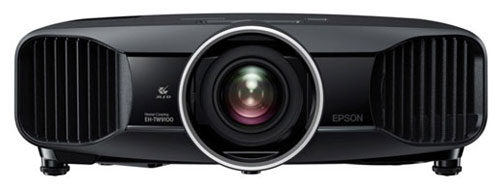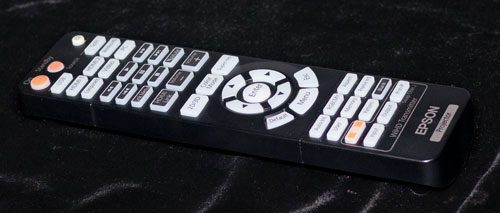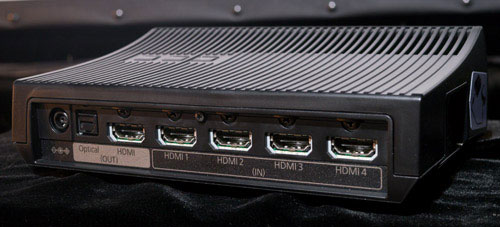HDTVTest’s second projector review happens to be from a manufacturer who doesn’t have a presence in the TV market. In fact, Epson is probably better known for office products, but the company has a presence in the home cinema space thanks to its line of projectors designed for precisely this purpose. The Epson EH-TW9100 and EH-TW9100W are the Japanese brand’s highest-end projectors, and are available from UK online stores for around £2600 and £2900 respectively, the cheaper of which omits HD wireless video capabilities. Both have the same LCD panels and optical components, and therefore have the same picture quality, although the non-wireless version comes in a more HT-friendly black colour. Both versions still have regular video inputs.
Let’s see how Epson’s top-end 3LCD effort fares against the competition!
| Display Technology | 3LCD |
| Approx. Lamp Life | 4000 hours |
| Lamp Product Code | ELPLP69 |
| Lens Shift | Yes, H+V |
Like Panasonic projectors, Epson’s top-end projector is a rectangular-shaped unit (in that it’s wider than it is long). Strangely, the wireless-capable Epson EH-TW9100W variant comes only in white; black would be more appropriate for a darkened cinema environment. The non-wireless-capable EH-TW9100 is black, however.

The Epson EH-TW9100 features fully manual lens controls. The horizontal and vertical lens shift, as well as zoom and focus, are controlled by dials on the top of the unit. We prefer the motorized solution, at least for focus, since it allows you to stand directly beside the screen and adjust focus with a remote control: getting pin-sharp adjustment on the TW9100 will take two people. On the other hand, the lens is protected by a door which slides out of the optical path when the projector is powered on, and back in again when it’s power-off time. For assisting the positioning of the projector with the screen, there are two foot-screws at the front of the unit.
There’s also a blue power LED, which can be disabled in the menu.

Epson’s remote reminds us of those bundled with Oppo Blu-ray Disc players, in that it’s chunky, comfortable to hold, and backlit in orange. There’s an impressive number of buttons on it, with discrete input selection and also shortcuts to picture settings (Frame Interpolation, Memory Recall, Auto Iris, and so on) that would normally take more presses to access via the menu.
Naturally, the Wireless HD transmitter can be controlled with the remote, too, if your model has it.
On projector:
 |
| Rear connections on Epson EH-TW9100 |
On wireless HD transmitter (Epson EH-TW9100W only):
 |
| Rear connections on wireless receiver (EH-TW9100W only) |
Epson’s user menus are refreshingly basic. We have nothing against full-colour animated menus, but having basic blocks of white-on-grey text gives us a hunch that maximum R&D effort has gone into improving the projected image quality rather than on trivialities.
A quick look around the web shows that the version of the EH-TW9100 sold overseas has a THX picture mode, and therefore has been through the THX display certification process. There is no THX branding to be found on the European version, and accordingly no THX picture mode, which is strange (given that projectors tend not vary between regions, and have no real reason to given that they don’t have tuners). Provided that there is a picture mode of equivalent accuracy and performance, the loss of this will not be a huge issue. (Oddly, the manual provided with our European unit makes reference to the missing mode, albeit with a footnote explaining that not all models have the feature). We’ll find out if this is a limitation when we calibrate the projector.
![[Image] menu](https://www.hdtvtest.co.uk/news/wp-content/uploads/2018/04/hardware_Epson-EH-TW9100_image.png) |
| [Image] menus |
The main picture menu is called “Image”, with the top level picture preset mode being called [Color Mode]. It’s essentially become an unwritten rule at this stage that when faced with this option, a “Cinema” or “Movie” mode is the one to reach for, since it’s usually the most accurate (we can interpret that as some measure of respect for the cinematographers’ wishes by manufacturers, although we argue that the benefits of accurate video should extend beyond films). On the Epson EH-TW9100, the “Cinema” option presents an incredibly wide colour gamut, which has the effect of making our consumer HD sources appear insanely saturated. Help is at hand, because the EH-TW9100’s “Natural” mode is extremely accurate (we’ll discuss this more during the Calibration section).
There are also “Dynamic” and “Living Room” modes, which prioritise light output at the expense of overall picture quality. We’d hope that home cinema projectors are being installed in home cinema rooms which have been light-treated, and that nobody will feel the need to reach for these modes, which push out ultra-bright, but tinted images.
There’s an [Abs. Color Temp.] option, which comes set to “6500K” (we’ll find out how close to 6500K it is during the calibration), and a secondary adjustment, labelled [Skin Tone]. Both of these settings affect white balance, and change the tint of the image. There’s a [Sharpness] control which can optionally be split into horizontal/vertical and high frequency/low frequency controls (labelled in user friendly terms, “Thick Line” and “Thin Line”), [Power Consumption] (we left this on “Eco” because the EH-TW9100 can put out a sufficiently bright image already), and an [Auto Iris] control which can be left off entirely, or set to “Normal” or “High Speed”.
![[Advanced] menu](https://www.hdtvtest.co.uk/news/wp-content/uploads/2018/04/hardware_Epson-EH-TW9100_advanced.png) |
| [Image] menus |
Meanwhile, there’s an [Advanced] menu which leads to controls over gamma, greyscale tracking, and three-axis colour management. Interestingly, there’s also a toggle over whether or not the projector clips whiter-than-white shades, which has, ostensibly, been pounced on by the marketing department: it’s not just called “Super White”, this control is called “EPSON Super White” (it’s the same as every other manufacturer’s implementation of a switch which enables or disables clipping of whiter-than-white shades).
There are a few more picture controls scattered elsewhere. The “Signal” tab contains control over Frame Interpolation features, as well as another edge enhancement control (we presume it’s been placed here to differentiate it for marketing reasons). Drilling down another level into [Advanced], there’s a [Noise Reduction] control (which we don’t need), an option to turn on [Overscan] (we left it off, to see the whole image and to avoid scaling artefacts), and an option to change [Image Processing] from “Fine” to “Fast” (for reducing input lag with video games).
And, last but absolutely not least, we have an “Extended” menu which houses the [LCD Alignment] feature. We’ll go into this in depth later in the review.
| Jump To: 1. DesignNext: Calibration3. Picture Quality |
jQuery(document).ready(function($) { var toc = $("#tableofcontents").html(); $("#tablecontents").html(toc); });